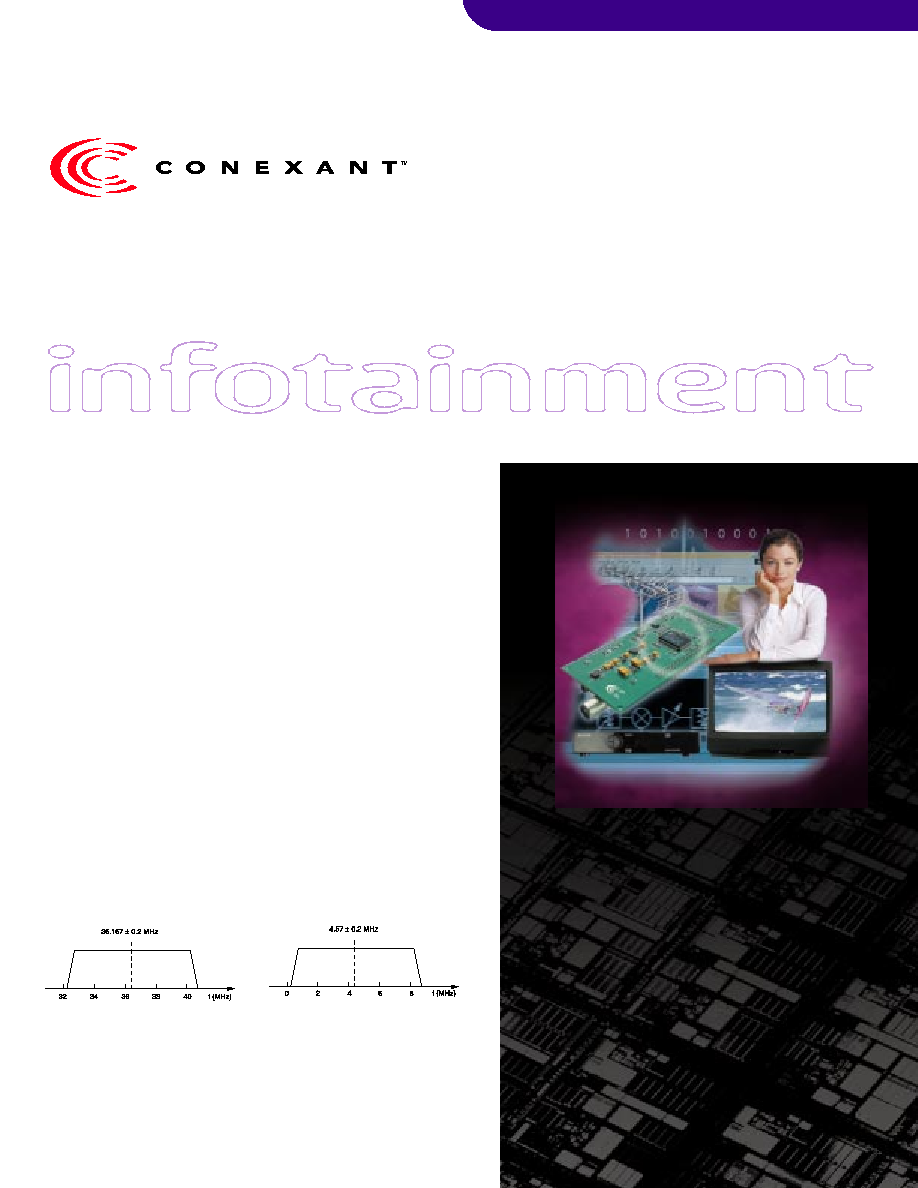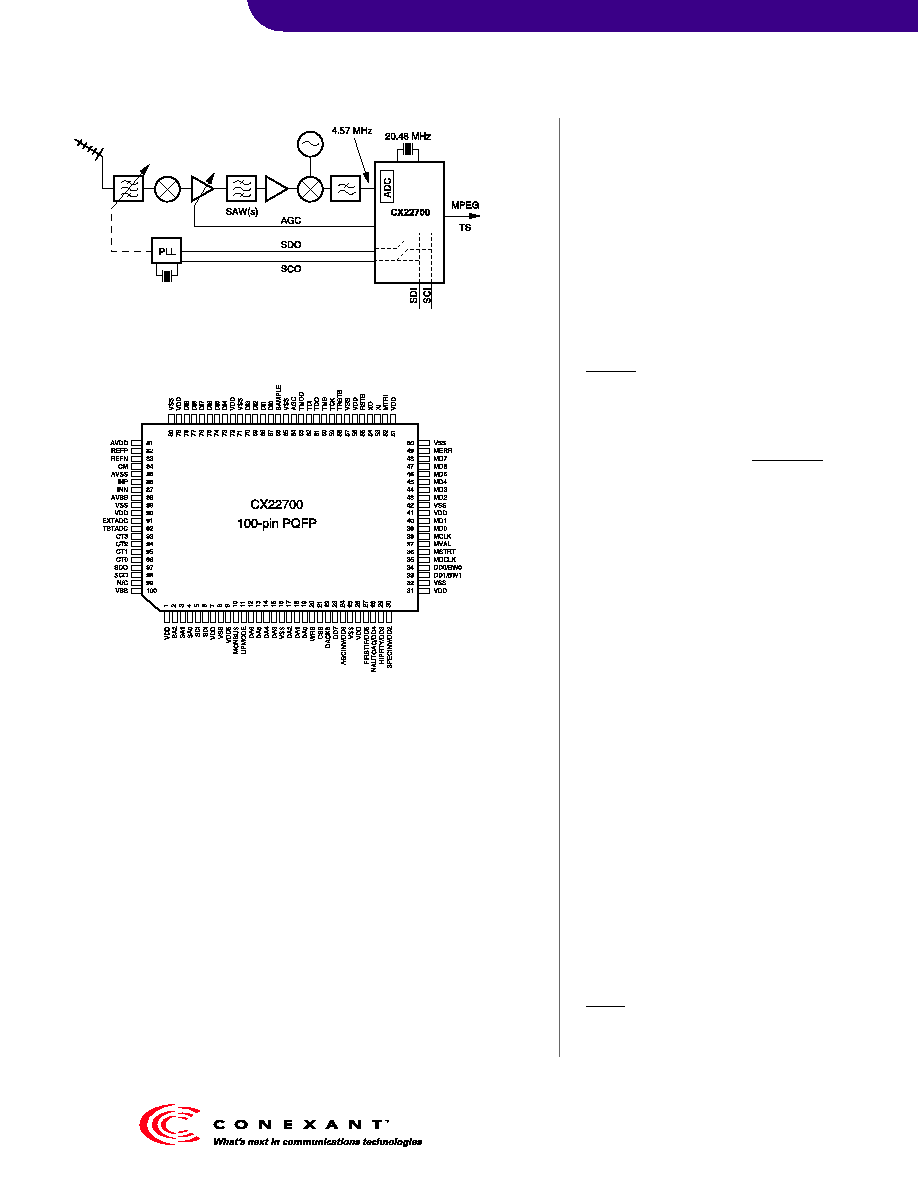 | –≠–ª–µ–∫—Ç—Ä–æ–Ω–Ω—ã–π –∫–æ–º–ø–æ–Ω–µ–Ω—Ç: CX22700 | –°–∫–∞—á–∞—Ç—å:  PDF PDF  ZIP ZIP |

d i g i t a l i n f o t a i n m e n t p r o d u c t s
Single-Chip Solution
for DVB-T Systems
C X 2 2 7 0 0
∑ Implements entire DVB-T standard
∑ High-IF sampling leading to low BOM
∑ Fast channel acquisition
∑ No real-time software requirement
∑ Field-proven high performance
Distinguishing Features
Figure 1. CX22700
input signal spectrum
(First IF Sampling)
Figure 2. CX22700
input signal spectrum
(Second IF Sampling)
Conexant's CX22700 is a single-chip Coded Orthogonal Frequency-
Division Multiplex (COFDM) demodulator/decoder solution for both 2K
and 8K terrestrial digital video broadcast-terrestrial (DVB-T) systems.
Offering a high level of integration, along with the ability to
sample the incoming signal at a first intermediate frequency (IF),
the CX22700 is a cost-effective device. In addition, its small
package outline makes the CX22700 ideal for use in tuner modules.
Input Signal
The CX22700 can accept an input signal centered either at a
First IF of approximately 36.167 MHz (Figure 1) or a Second IF of
approximately 4.57 MHz (Figure 2). This is normally an analog
signal, which is sampled using the internal 10-bit analog-to-digital
converter (ADC). The CX22700 uses digital filters to remove
adjacent channel signals (e.g., NICAM). The tuner's automatic
gain control (AGC) is controlled via a single-pin sigma-delta
feedback. Only a simple RC filter is required to generate the
analog control voltage.

Single-Chip Solution
for DVB-T Systems
C X 2 2 7 0 0
d i g i t a l i n f o t a i n m e n t p r o d u c t s
From IF Input to MPEG Output
The CX22700 performs all the functions required to
produce an MPEG transport stream output from the
IF input. The time domain adapter enables the chip to
address 6-, 7-, and 8-MHz bandwidth channels as well
as adapt to different IFs, sample timing and frequency
offsets. In addition, the time domain adapter removes
adjacent channel interference, such as NICAM, and
removes the cyclic prefix prior to the Fast Fourier
Transform (FFT). During channel acquisition, the time
domain adapter uses a set of algorithms that allow
frequency, sample timing, and guard interval lock to
be achieved quickly and reliably before switching to
a different set of algorithms, which provide good
tracking performance.
After the FFT, a common phase error correction is
applied prior to channel estimation and correction.
Scattered and continual pilot carriers are used to
correct channel distortion, fading, and phase noise
within the carrier bandwidth. The channel estimate is
also used to provide channel state information (CSI),
which is passed on to the Viterbi decoder, where it is
used to improve performance by identifying bits from
data carriers that have been subject to severe fading.
CSI can also be used to mask bits from data carriers
that are particularly affected by co-channel analog
interference (e.g., PAL/SECAM). The CX22700 uses
proprietary memory-efficient algorithms to produce
the channel estimate. By default, the CX22700 initially
determines all transmission parameters (including
2K/8K transmission mode and guard interval) from
the received signal. These parameters are stored and
used to reduce the time needed for subsequent
channel acquisitions.
The CX22700 can be interfaced directly to all commonly
available MPEG transport demultiplexer chips, as well
as directly to a DVB common interface. The data rate
is smoothed to remove gaps introduced by the
COFDM guard interval and variation in processing
time within the forward error correction (FEC) circuitry.
This allows a stable clock reference to be extracted
from the transport stream more quickly, further
reducing the overall time before the viewer sees
a picture.
Applications
Figures 4 and 5 show two possible applications of
the CX22700 using a conventional tuner architecture.
Figure 4 is an example of First IF sampling, where an
input signal centered on 36.167 +/≠ 0.2 MHz is sampled
directly. This method considerably reduces the
component count in the tuner, allowing a mixer
and oscillator to be replaced by an amplifier, which
provides the required input level for the ADC.
Figure 3. CX22700 functional block diagram

Many standard tuners have an IF output at about 4.57 MHz
(32/7 MHz), so the CX22700 can also sample a signal centered on
this frequency. Selection is made using either a pin on the device
(First IF) or a register. In both cases, adjacent channel interference
at the same level as the COFDM signal is removed by digital filtering
inside the CX22700.
Figures 4 and 5 also show how a two-wire serial host interface
bus to the tuner can be switched inside the CX22700. The
connection to the tuner is switched on or off by setting a register
bit inside the CX22700, reducing noise in the tuner caused by
activity on the bus.
If users do not need some of the more advanced features of the
CX22700, then they do not need to connect it to a host processor.
In this case, some of the pins of the parallel host interface data
bus are used to select the mode of operation (e.g., channel
bandwidth, spectrum inversion, and IF sampling). However,
Conexant can provide proven reference designs which integrate
all the software required for a complete receiver design.
What is COFDM?
Coded Orthogonal Frequency Division Multiplexing
(COFDM) is the method adopted by the Digital Video
Broadcasting (DVB) Group for digital terrestrial broadcasting.
(Here, "terrestrial" refers to land-based, as opposed to
satellite broadcasting). To understand what this acronym
means, let's break it down into its component parts.
Frequency Division Multiplexing (FDM) refers to the division
of a communications channel into different frequency
bands. This is a commonly used technique in analog TV
broadcasting, in which different TV stations broadcast
on different frequencies. But in analog TV, the carrier
frequencies are spaced 6 or 8 MHz apart; in DVB-T, there
are 2,048 carriers (with "2K" mode) or 8,192 carriers
(using "8K" mode) in a given 6 or 8 MHz band. Using
conventional techniques, carriers spaced this close together
would interfere with each other. But because the carriers
are "orthogonal," or non-overlapping, they do not.
As a TV signal travels between the transmitter and the
receiver, it may encounter interference from a variety of
sources. In addition, echoes occur as the signal is reflected
from hills, buildings, trees and moving objects. These
echoes interfere with the signal and cause it to fade. By
coding the signal using powerful error-correction techniques
(the "Coded" in COFDM), data in carriers that have been
destroyed by interference can be recovered. Because of
these capabilities, COFDM has proven itself superior to
other methods of digital terrestrial broadcasting.
Figure 4. CX22700 possible application
(First IF Sampling)

f e a t u r e s a n d s p e c i f i c a t i o n s
Product Features
∑ Implements complete DVB-T
(ETS 300 744) standard
∑ Digital Television Group (DTG) and
EACEM compliant
∑ 2K and 8K transmission modes
∑ All non-hierarchical and hierarchical
modulation constellations
∑ Smart single frequency network
channel acquisition
∑ Decoded transmission parameter signaling
(TPS) data can be used and made available
to the host CPU
∑ Integrated ADC
∑ Internal digital AFC loop (no feedback to tuner)
∑ Internal digital clock recovery loop
(fixed frequency input, no need for VCXO)
∑ Single-pin
D
AGC feedback to tuner
∑ Channel estimation and correction
∑ Common phase error correction
∑ Fast channel acquisition (<100 ms)
∑ Maintains and uses channel state
information (CSI)
∑ Serial (I
2
C compatible) and parallel
host interfaces
∑ Can achieve automatic lock from initial
frequency offsets of over 200 KHz
∑ 6-, 7- and 8-MHz channel support to address
all global markets
∑ MPEG transport stream output suitable for
direct connection to transport Demux chips
∑ Minimal host software required
(in some cases none)
∑ 100-pin PQFP
∑ JTAG boundary scan
Conexant and the Conexant symbol are trademarks of Conexant Systems, Inc.
www.conexant.com
Figure 5. CX22700 possible application
(Second IF Sampling)
Figure 6. CX22700 pin diagram
Further Information
literature@conexant.com
(800) 854-8099 (North America)
(949) 483-6996 (International)
Order # 100744A
00-0272
Digital Infotainment
Printed in USA
World Headquarters
Conexant Systems, Inc.
4311 Jamboree Road
Newport Beach, CA
92660-3007
Phone: (949) 483-4600
Fax 1: (949) 483-4078
Fax 2: (949) 483-4391
Americas
U.S. Northwest/Pacific Northwest
≠ Santa Clara
Phone: (408) 249 -9696
Fax: (408) 249 -7113
U.S. Southwest ≠ Los Angeles
Phone: (805) 376 -0559
Fax: (805) 376 - 8180
U.S. Southwest ≠ Orange County
Phone: (949) 483-9119
Fax: (949) 483-9090
U.S. Southwest ≠ San Diego
Phone: (858) 713-3374
Fax: (858) 713-4001
U.S. North Central ≠ Illinois
Phone: (630) 773-3454
Fax: (630) 773 -3907
U.S. South Central ≠ Texas
Phone: (972) 733-0723
Fax: (972) 407- 0639
U.S. Northeast ≠ Massachusetts
Phone: (978) 367-3200
Fax: (978) 256 - 6868
U.S. Southeast ≠ North Carolina
Phone: (919) 858 -9110
Fax: (919) 858 - 8669
U.S. Southeast ≠ Florida/
South America
Phone: (727) 799 - 8406
Fax: (727) 799 - 8306
U.S. Mid-Atlantic ≠ Pennsylvania
Phone: (215) 244- 6784
Fax: (215) 244- 9292
Canada ≠ Ontario
Phone: (613) 271-2358
Fax: (613) 271-2359
Europe
Europe Central ≠ Germany
Phone: +49 89 829 -1320
Fax: +49 89 834-2734
Europe North ≠ England
Phone: +44 1344 486444
Fax: +44 1344 486555
Europe ≠ Israel/Greece
Phone: +972 9 9524000
Fax: +972 9 9573732
Europe South ≠ France
Phone: +33 1 41 44 36 51
Fax: +33 1 41 44 36 90
Europe Mediterranean ≠ Italy
Phone: +39 02 93179911
Fax: +39 02 93179913
Europe ≠ Sweden
Phone: +46 (0) 8 5091 4319
Fax: +46 (0) 8 590 041 10
Europe ≠ Finland
Phone: +358 (0) 9 85 666 435
Fax: +358 (0) 9 85 666 220
Asia ≠ Pacific
Taiwan
Phone: (886 -2) 2-720-0282
Fax: (886 -2) 2-757- 6760
Australia
Phone: (61-2) 9869 4088
Fax: (61-2) 9869 4077
China ≠ Central
Phone: 86 -21- 6361-2515
Fax: 86 -21- 6361-2516
China ≠ South
Phone: (852) 2 827- 0181
Fax: (852) 2 827- 6488
China ≠ South (Satellite)
Phone: (86) 755 -5182495
China ≠ North
Phone: (86 -10) 8529 - 9777
Fax: (86 -10) 8529 - 9778
India
Phone: (91-11) 692-4789
Fax: (91-11) 692 -4712
Korea
Phone: (82-2) 565-2880
Fax: (82-2) 565-1440
Korea (Satellite)
Phone: (82-53) 745-2880
Fax: (82-53) 745-1440
Singapore
Phone: (65) 737 7355
Fax: (65) 737 9077
Japan
Phone: (81-3) 5371 1520
Fax: (81-3) 5371 1501



